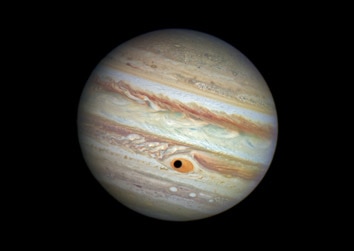Create a free profile to get unlimited access to exclusive videos, sweepstakes, and more!
Shmutz in Jupiter’s Pupik

I remember when I was in grad school, running a telescope observing lab. I was setting up the telescopes, and Jupiter was well placed in the sky, so I was using it to align the finderscopes and get things focused. By coincidence, one of its moons, Io, happened to be just on the edge of Jupiter’s broad face when I looked. Over the course of the three hour lab, we all took turns going back to that ’scope to see how much Io had moved. By another sheer coincidence, Io takes about three hours to cross Jupiter’s disk, so the transit ended just as the lab did.
It was mesmerizing. But it was nothing like this:
That’s how Hubble sees Jupiter, which is way better than my old (otherwise very nice) 25 cm ’scopes did. You can see the broad bands and swirly festooned storms all over its cloud tops. But what really gets you is the ridiculously huge Great Red Spot, big enough to swallow the Earth.
And as if even that isn’t cool enough, there’s a big black spot on it: That’s the shadow of the moon Ganymede, which happened to fall right across the Spot when the shot was taken.
Jupiter’s moons orbit the planet above its equator, and Jupiter has almost no axial tilt (unlike the Earth, where our spin axis is tipped about 24° to the plane of our orbit). That means Jupiter’s moons pass directly between the planet and the Sun every orbit, casting their shadows on the clouds (Jupiter doesn’t have a solid surface; we only see the top of its dense atmosphere, which is tens of thousands of kilometers deep).
I’ve seen moon shadows on Jupiter many times through telescopes, but I’ve never seen one throw its shadow over the Spot! That’s really cool. And what really strikes me is how big Ganymede’s shadow is compared with the Spot. There are two reasons for that: One is that Ganymede is big, 5,270 km across—bigger than the planet Mercury! So it casts a huge shadow.
But also, the Great Red Spot over the years has become somewhat less Great. It’s shrinking. In the past 40 years it’s lost more than 30 percent of its width, and no one knows why.
Incidentally, another mystery is why the Spot is red. Is it from material upwelling from deep within Jupiter's atmosphere, or is it from something else? A new study indicates that it might be due to gases and other material in the upper atmosphere of the planet that get smacked by solar ultraviolet light, changing their chemistry. In the lab, such a process has created a red gas similar to what's seen in the Spot. I can't say if it's conclusive, but it's an interesting step in solving this long-standing enigma.
Anyway, the picture above, released the week of Halloween, was being sold as “Spooky Shadow Play Gives Jupiter a Giant Eye.” I am a master observer of pareidolia, and I’m not buying this. It looks a little like an eye to me, but the placement and relative dimensions don’t look right. If pressed, I’d say it looks more like a jovian belly button.
So maybe, instead of using Hubble, they should have taken this picture with the Naval Observatory.


























